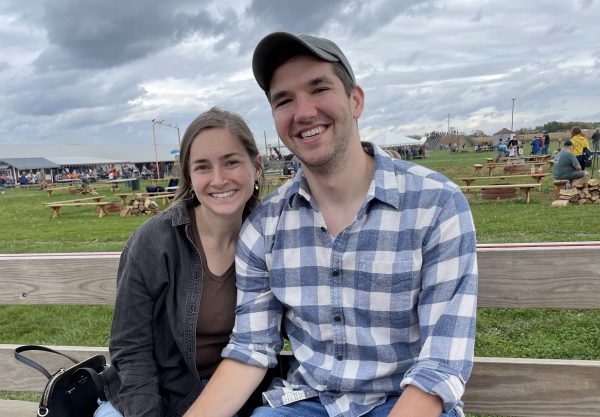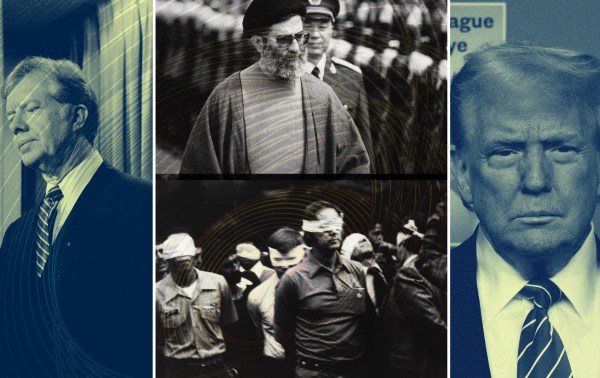Hello, Dispatch members! Thank you for all your questions and for being members of the Dispatch community. We obviously couldn’t do our jobs without your support, but it’s an extra privilege to be writing for such curious and receptive readers. We often say that the Dispatch comments section is the one corner of the internet that actually works, and we’re very blessed for that.
Okay, pandering aside, let’s get to what you’re really here for! You’ve got questions, and I’ve got some attempts at answers. I’ve organized these loosely by topic with a rapid-fire section at the end. I hope you enjoy!
First Things First: Lola

My wife, Audrey, and I recently moved from New York to Philadelphia, and one perk of the relocation was being able to finally get a dog, something we’d both wanted for years. We fell in love with the pitbulls we met in our neighborhood while living in Brooklyn, and knew we eventually wanted one of our own. We started looking at dogs to adopt less than a week after moving to Philly, and—with boxes still strewn throughout our new place—we brought home Lola, an almost four-year-old pit mix.
Lola is a sweetheart. She loves being around people but doesn’t beg for pets or attention. She’s perfectly content to just sit on the floor near you or, as is often the case, take a nap in my office reading chair while I’m working on TMD. She’s sometimes over-excited to meet new people, but she’s also very food-motivated—the other day she ate a banana, peel and all, that she snagged while we were unpacking groceries—which has made training her pretty easy.
On Studying History
I took a couple of semesters off after joining The Dispatch, but I’m part-way through an online graduate history degree at the University of Edinburgh and am hoping to pick up classes again this fall. The courses I’ve taken/plan to take are focused on modern American politics and the Civil War era. Bendegrow raised a great question that gets at why I find history and historiography—the study of the writing of history—so fascinating: How badly does the average person you meet understand historiography in light of the often-overused epithet of “revisionist history”?
Before I started studying and thinking about history, I probably misused the idea of “revisionist history,” thinking that history is largely facts about the past set in stone and that attempts to change historical narratives, particularly about American history, are largely ahistorical, progressive attempts to discredit the past and the American story.
That view really misunderstands historical writing. The study and writing of history is a much more dynamic process than many people realize. Historical writing is an ongoing debate among scholars who advance competing arguments, sometimes informed by newly unearthed historical evidence but more often by a reconsideration of the existing record in light of a new vantage point in time.
There’s debate within the discipline, but I’m sympathetic to the view of history outlined in E.H. Carr’s 1961 classic What Is History, one of the more influential books on historiography. It’s a bit philosophical and heady but offers a succinct introduction to modern debates about academic history.
“The belief in a hard core of historical facts existing objectively and independently of the interpretation of the historian is a preposterous fallacy,” Carr argued. “Of course, facts and documents are essential to the historian. But do not make a fetish of them. They do not by themselves constitute history; they provide in themselves no ready made answer to this tiresome question: what is history?” For Carr, history is “a continuous process of interaction between the historian and his facts, an unending dialogue between the present and the past.”
Take the history of conservatism in America. Conservatives today probably wouldn’t like it much if we had hit pause in the post-WWII era on historical conceptions of American conservatism—a time when historical thinking about conservatives was dominated by Richard Hofstadter’s “Paranoid Style” and Lionel Trilling’s view of conservative thought as “irritable mental gestures which seek to resemble ideas.” The late, great historian Alan Brinkley’s 1994 essay, “The Problem of American Conservatism,” helped spark a scholarly re-evaluation of the history of the American right leading to rich new histories written by folks like Lisa McGirr. Trump’s election has driven some of those same historians to consider whether they overcorrected in trying to remedy the errors of the mid-century historians, not giving sufficient attention to the darker strains of thinking on the right. Regardless, the point is that the process of historical thinking is ongoing, and it’s a mistake to view that process as inherently suspect.
On Reading History
Okay, enough of that nerdery, here are some of my favorite history books. Randall Briggs beat me to it with Battle Cry of Freedom by James McPherson, arguably the best single-volume history of the Civil War. McPherson is eminently readable and offers a masterclass in clarity and concision without sacrificing nuance. (If war history isn’t your thing, I’d still recommend reading the first ~275 pages of the book as they provide a wonderful survey of the social, economic, and political history of the country before the war began)
Sticking with the same era, The Field of Blood: Violence in Congress and the Road to Civil War by Joanne Freeman is a great read if only as a reminder that the dynamics among lawmakers on Capitol Hill used to be much worse than they are now. But it also serves as a warning of what can happen when the threat of violence creeps back into the halls of Congress.
Leslie asked about history book recommendations for her two sons while her family hops the pond. For the 11th grader, I’d recommend Jill Lepore’s These Truths. It’s a fantastic single-volume history of America. I’m a big Lepore fan (her book, This America: The Case for the Nation is a great compact read). Here’s a taste of Lepore’s approach to American history from the introduction to These Truths.
Some American history books fail to criticize the United States; others do nothing but. This book is neither kind. The truths on which the nation was founded are not mysteries, articles of faith, never to be questioned, as if the founding were an act of God, but neither are they lies, all facts fictions, as if nothing can be known, in a world without truth. Between reverence and worship, on the one side, and irreverence and contempt, on the other, lies an uneasy path, away from false pieties and petty triumphs over people who lived and died and committed both their acts of courage and their sins and errors long before we committed ours. “We cannot hallow this ground,” Lincoln said at Gettysburg. We are obliged, instead, to walk this ground, dedicating ourselves to both the living and the dead.
For the 7th grader, I’d actually recommend a work of fiction: The Killer Angels by Michael Shaara. The book won the Pulitzer Prize in 1975, and in my opinion, is the best Civil War novel out there. It follows the real historical events of the Battle of Gettysburg through real historical characters. Michael’s son, Jeff Shaara has carried on his father’s project, writing books about nearly every American war. Here’s a good clip of Jeff explaining the premise of The Killer Angels. If he enjoys that, he might also like Jeff’s four-part World War II series, which I devoured in high school.
On TMD and ‘9 a.m. Questions’
Declan and Mary pretty well covered the process of how The Morning Dispatch comes together each day (you should check out their mailbags if you haven’t already). The logistics have shifted some as the team has changed, but the main thrust of it is the same.
I threw the “9 a.m. questions” topic out there because it really informs how we approach writing for TMD. When you’re writing explanatory pieces on a beat as wide as TMD’s, it’s helpful to have some kind of heuristic to approach different topics, particularly unfamiliar ones, and that’s where the questions come in.
When I first started at The Dispatch in early 2023, Declan shared his process for writing outlines by thinking of the important questions that would need to be answered to understand a story. If you imagine that you’re trying to explain a news development to someone with no knowledge of it, think of the questions you’d need to answer to give a full picture of the story. Organize them in a logical way, and there’s not only the skeleton of your piece but also a road map for your reporting. It sounds simple, but it’s a powerful way to focus on what’s essential or nonessential to a story. The outline will change some as you learn more through your reporting, but most of those questions will be the ones answered in the finished product.
After working on TMD for about six months, I came across a podcast interview with Derek Thompson—an Atlantic writer and one of my favorite explanatory journalists—that nailed this process. In the interview, Thompson explained how he approached writing about economics when he got his first job at The Atlantic despite never having covered economics before:
I’m going to wake up every morning, and there’s going to be a question that I have no idea what the answer is to. Maybe something like, ‘Where does unemployment come from and what kind of public policies are necessary to bring unemployment down?’ I have no idea at 8:30, at 9 o’clock. But I’ll spend that entire day reading, talking to economists, talking to other journalists who know more than me. And by 3 or 4 o’clock maybe I’ll be able to write that article about what kind of public policies bring down unemployment. But I have to be careful to remember my 9 a.m. self and write the article for my 9 a.m. self. Don’t write the article in such a way as to make it seem like, ‘Oh you’ve taken that PhD class,’ ‘Oh you’re smart enough that you can use a bunch of buzzwords and acronyms and just get by on being arcane.’ No, write it as if you’re writing for someone as simple-minded as you were six hours ago.
On Golf
Enterprising readers will note that the photo at the top of this mailbag was taken at Pebble Beach. I’ve never played there, but hopefully will someday! My dad taught me the basics of golf when I was growing up, but I didn’t play very much. A couple of summers ago, I decided to pick it up again, and Audrey joined me. Now, we’re well on our way to becoming full-on golf nuts.
Why take up golf? Tiger Woods may have best explained why the game is so captivating to watch and play:
Anyone who’s ever played the game can relate to us. I can’t relate to someone who can dunk from the foul line or who can kick a soccer ball 60 yards in the air. I can’t relate to that because I can’t do that. They can relate to us golfers because they can do that. They can make a six-foot putt. They can hit that shot 100 yards and know how it feels to be nervous cause there’s water there, there’s bunkers there, there’s trouble everywhere. They know how that feels. It is fascinating to people who have played the game on any level, whether they’re great at it or they’re terrible at it. It doesn’t matter.
And you don’t just relate to the pros, you can relate to anyone who plays: friends, family, or random golfers you’re paired with at the course. It’s a lifelong and intergenerational game. My dad will probably still be able to beat me 20 years from now, and my grandpa still tees it up at age 86.
Craig B: Since you’re a golf guy and a dude at a philosophically traditional conservative site, I’m interested in your thoughts on PGA/LIV. Are you on the “free market” side, that they are independent contractors and you have no problem with golfers selling their wares to the highest bidder? Or are you on the “institutional” side, that these players should have some respect for those who built the PGA Tour and not undermine the existing order for some (admittedly large sums of) money?
I liked the way you framed this question! (For those of you asking about what’s happened with the PGA Tour and LIV, you can check out some of my reporting from last summer on the situation.) One could say a more libertarian and capitalist position would be fine taking money from the Saudi sovereign wealth fund—it’s bringing competition and innovation (e.g., a new format) to the world of golf—and that a more Burkean approach might emphasize the value of tradition and the legacy of the PGA Tour.
But Burke also recognized the importance of adjusting to change. “We must all obey the great law of change, it is the most powerful law of nature, and the means perhaps of its conservation,” he wrote in a late-18th century letter arguing that Ireland’s Roman Catholics should be granted elective franchise. I’m sympathetic to the argument that the Saudis were going to be involved in professional golf no matter what—it’s part of their long-term strategy to diversify their economy away from oil. But I think the major error was Jay Monahan and the Tour leadership taking such a heavy-handed, moral position against LIV only to pull a 180.
I understand the moral opposition to doing business with the Saudis and their strategy of sportswashing. But if the Saudi presence in the game was inevitable, then coming to some sort of accommodation could have been far less divisive and damaging if the Tour leadership had acted like realists from the start. It’s not that different from how the U.S. government treats its relationship with Saudi Arabia, for that matter—we’re poised to finalize a security pact with them soon. As a side note, I don’t care as much for LIV’s 54-hole format, but I would be in favor of more true team golf formats like the Zurich Classic.
At the end of the day as a fan, I want to see more of the top players—Brooks, Bryson, Rahm— going up against the PGA Tour’s best more often than just the four majors championships.
On Cocktails, Bars, and Coffee
Cal Amari: Thoughts on Death & Co.? (book and/or bar) (Somewhat related) What are your most used cocktail/bartending books?
The cocktail books I use most often are Death & Co.’s Modern Classic Cocktails and Cocktail Codex. But I’m also a subscriber to Peter Suderman’s Substack, Cocktails with Suderman, and I pull a lot from various bars and bartenders I follow on social media. Once I find a recipe that I like, it goes into our personal home bar menu.
It also helps to be colleagues with Alex Demas, who’s a true enthusiast and a great resource for bar and cocktail recommendations.
Cal Amari: Could you please provide ALL of your favorite craft cocktail bars, (preference for drink quality over other factors)?
We’d be here for a while if I included all of my favorites, but here’s a good sampling:
- Post Haste – Philadelphia
- Altar – Brooklyn
- Bar Francis – Brooklyn
- Long Island Bar – Brooklyn
- Tooker Alley – Brooklyn
- Little Branch – Manhattan
- Lobby Bar at the Chelsea Hotel – Manhattan
- Amor Y Amargo – Manhattan
- Service Bar (h/t Alex) – Washington, D.C.
- Allegory – Washington, D.C.
- Swizzle Rum Bar & Drinkery – Miami Beach
- Noble Experiment – San Diego
- Lobby Bar at the Lafayette Hotel – San Diego
- Part Time Lover – San Diego
- House Without a Key – Waikiki
John Boland: Favorite cocktail? Favorite cocktail to drink while reading a history book?
I’m horrible at favorites, but I discovered the Going Out West cocktail recently and have really enjoyed it. It’s a great option for an after-dinner drink that still has some heft to it. Chocolatey with some smoke, it’s the perfect balance between a robust cocktail and an easy sipper.
- 1 oz. rye whiskey (preferably Rittenhouse)
- 0.5 oz. Mezcal (I use Del Maguey Vida Mezcal)
- 0.5 oz. Averna
- 1 tsp. Simple Syrup (you can use a little more, but I prefer the drink stiffer)
- 2 dashes of Angostura bitters
- Orange peel garnish
Stir with ice and strain into a rocks glass with a big cube.
I often read in the evenings, and if it’s not too late, I typically enjoy sipping on some kind of boozy whiskey/whisky cocktail like a Scotch Dram. The drink is essentially a combination of Rob Roy and a Rusty Nail.
- 2 oz. of a peaty scotch (I use Laphroaig)
- 0.75 oz. sweet vermouth (Dolin or Carpano Antica Formula if you have it, steer clear of Martini & Rossi)
- 0.25 oz. Drambuie
- 1 dash of Peychaud’s bitters
- Optional: garnish with a cherry or a lemon twist
Stir with ice and strain into a chilled glass, my preference is a Nick & Nora.
If it’s later in the night, I’ll often opt for an Amaro on the rocks—Cardamaro, Pelinkovac (not technically an Amaro since it’s not Italian), and Centerbe are some of my favorites.
Whiskeyman: What is your go-to drink? You’re in a bar or restaurant, you don’t know how they roll or what they’re good at, and you need to order something now.
Scotch and soda. It never lets me down.
Howmanydiscs: What’s your preferred coffee brewing method at home? Do you grind your own beans? French press, Chemex, or V-60? That sort of thing.
We grind our own beans and were Chemex drinkers for years, but we broke ours a few months back. More recently, I’ve been enjoying AeroPress for my daily coffee. I take my coffee black, but on the weekends I sometimes enjoy a French press with milk and sugar, preferably while reading the Sunday paper.
Harris12412 asked about making a cocktail menu for a house party. If you’re a true nerd at something, it can sometimes pose a high barrier for people to enjoy that thing with you. I’ve often come across the problem of choice paralysis with a friend who enjoys a good cocktail, but doesn’t necessarily know how to respond when you tell them you have the ingredients for just about anything. A good cocktail menu helps solve that problem. I try to keep things small—five or six options, max—with a mix of some light options like a spritz, a couple of sweeter, easy drinkers, and one or two spirit-forward options.
If you’re hosting a larger group, I’d recommend having a few drinks that you can make ahead of time—Martini and Manhattan formats are easy to batch and throw in the freezer. The first cocktail menu I made was for Thanksgiving and every drink had to be made individually, which kept me at the bar for a good chunk of the evening. (TMD readers got a sample from that menu in our Thanksgiving newsletter.)
Odds and Ends
Viki: Have you met Pippa and Zoë? If so, did they have any impact on your decision to get a dog?
I have had the wonderful privilege of meeting Pippa and Zoë, both excellent doggos. My decision to get a dog certainly predated the meeting, but we could say they only heightened my resolve.
Faraday: So during the Dispatch Live events, you may have noticed a bit of a running commentary re: Bond Villains. While Kevin definitely emits the aura and presence of a Bond Villain (he really just needs to be stroking a cat on one of the Live events to complete the look, your name very much fits the bill (all in good fun but feel free to roll with this if you so choose). That said, have you ever been contacted by SMERSH or SPECTRE and, if so, can you discuss any of the related conversations? 😎
I simply can’t comment on this inquiry without compromising sources and methods. I will simply say that one of my favorite martini formats is a variation on the Vesper, although not prepared in the abominable fashion that 007 requested. Stirred—always stirred.
Bendegrow: What one or two popular history books (nonfiction or historical fiction) would you classify as your favorite guilty pleasures that you wouldn’t brag about reading in grad school?
No reading is a guilty pleasure! I really like Erik Larson. He writes non-fiction that truly reads like a novel. I loved In the Garden of the Beasts: Love, Terror, and an American Family in Hitler’s Berlin and The Splendid and the Vile: A Saga of Churchill, Family, and Defiance During the Blitz. His latest book, The Demon of Unrest, is about the start of the Civil War, and it’s on my shelf.
Evelyn and Chad.Ingels asked what’s up with the Blain’s Farm & Fleet hat. My grandparents on my dad’s side live in Central Illinois, and when we visited them growing up, I always loved going to Blain’s. A couple of summers ago I spotted that hat on a trip to Blain’s and thought to myself that it actually looks like something I would see in Brooklyn—trucker hats are big with the hipsters. Sure enough, a month after I bought the hat, I saw someone else wearing the exact same one in Brooklyn.
Last but not least, I have to give a shout-out to an old teacher of mine who I was pleasantly surprised to find in the comments section. Mrs. Franklin, I hope all is well, and thanks for putting up with me in class!










Please note that we at The Dispatch hold ourselves, our work, and our commenters to a higher standard than other places on the internet. We welcome comments that foster genuine debate or discussion—including comments critical of us or our work—but responses that include ad hominem attacks on fellow Dispatch members or are intended to stoke fear and anger may be moderated.
With your membership, you only have the ability to comment on The Morning Dispatch articles. Consider upgrading to join the conversation everywhere.